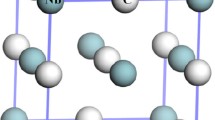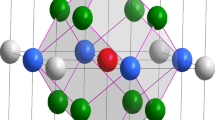Abstract
Nb-doped TiAl alloys exhibit excellent mechanical properties at high temperatures, and the underlying mechanism and optimal doping amount remain elusive. Molecular dynamics simulation is helpful to clarify these problems, but most of the existing interatomic potentials are limited to the Ti−Al binary system and lack interatomic potentials for doped alloys. Here, an interatomic potential of Nb−Al−Ti ternary systems based on the modified embedded-atom method was developed. The ternary potential can accurately predict the structure and thermodynamic properties of the Nb−Al−Ti system. The potential shows that the optimal Nb content for high-temperature strength-ductility synergy of TiAl single crystals is 8%, consistent with the amount of miracle synthesis of TiAl single crystals. Tensile simulations further show that the developed potential can make an effective prediction at high temperatures, indicating the potential for the development and applications of high-temperature Nb−Al−Ti ternary systems.

摘要
铌(Nb)掺杂的TiAl合金在高温下具有优异的力学性能, 但其机理和最佳掺杂量尚不清楚. 分子动力学模拟有助于澄清这些问题, 但现有的原子间势场大多局限于Ti−Al二元体系, 缺乏适用于掺杂合金的原子间势场. 文章基于改进的嵌入原子法, 建立了Nb−Al−Ti三元系的原子间势场. 三元势能很好地预测Nb−Al−Ti体系的结构及其热力学性质. 电位分析表明, TiAl单晶高温强塑性协同效应的最佳Nb含量为8%, 与TiAl单晶的合成量一致. 拉伸模拟进一步表明本文所发展的电位可以有效预测材料在高温下的力学性能, 显示了高温Nb−Al−Ti三元系的发展和应用潜力.
Similar content being viewed by others
References
F. Appel, H. Clemens, and F. D. Fischer, Modeling concepts for intermetallic titanium aluminides, Prog. Mater. Sci. 81, 55 (2016).
H. F. Appel, J. D. H. Paul, and M. Oehring, Gamma Titanium Aluminide Alloys: Science and Technology (Wiley-VCH Verlag GmbH & Co. KGaA, 2011).
P. E. Blöchl, Projector augmented-wave method, Phys. Rev. B 50, 17953 (1994).
D. Chen, M. Yan, and Y. F. Liu, A modified embedded-atom potential for L10 γ-TiAl, Scripta Mater. 40, 913 (1999).
G. Chen, Y. Peng, G. Zheng, Z. Qi, M. Wang, H. Yu, C. Dong, and C. T. Liu, Polysynthetic twinned TiAl single crystals for high-temperature applications, Nat. Mater. 15, 876 (2016).
W. M. Choi, Y. H. Jo, S. S. Sohn, S. Lee, and B. J. Lee, Understanding the physical metallurgy of the CoCrFeMnNi high-entropy alloy: an atomistic simulation study, npj Comput. Mater. 4, 1 (2018).
S. F. Clark, 787 Propulsion System (Boeing, 2012), http://go.nature.com/29oA2VJ.
D. Faken, and H. Jónsson, Systematic analysis of local atomic structure combined with 3D computer graphics, Comput. Mater. Sci. 2, 279 (1994).
D. Farkas, Interatomic potentials for Ti−Al with and without angular forces, Model. Simul. Mater. Sci. Eng. 2, 975 (1994).
D. Farkas, and C. Jones, Interatomic potentials for ternary Nb−Ti−Al alloys, Model. Simul. Mater. Sci. Eng. 4, 23 (1999).
B. H. Kear, and E. R. Thompson, Aircraft gas turbine materials and processes, Science 208, 847 (1980).
J. Hafner, Ab-initio simulations of materials using VASP: Density-functional theory and beyond, J. Comput. Chem. 29, 2044 (2008).
X. Huang, L. Liu, X. Duan, W. Liao, J. Huang, H. Sun, and C. Yu, Atomistic simulation of chemical short-range order in HfNbTaZr high entropy alloy based on a newly-developed interatomic potential, Mater. Des. 202, 109560 (2021).
M. S. Kesler, S. Goyel, F. Ebrahimi, and M. V. Manuel, Effect of microstructural parameters on the mechanical behavior of TiAlNb(Cr, Mo) alloys with γ+σ microstructure at ambient temperature, J. Alloys Compd. 695, 2672 (2017).
H. K. Kim, W. S. Jung, and B. J. Lee, Modified embedded-atom method interatomic potentials for the Fe−Ti−C and Fe−Ti−N ternary systems, Acta Mater. 57, 3140 (2009).
Y. K. Kim, W. S. Jung, and B. J. Lee, Modified embedded-atom method interatomic potentials for the Ni−Co binary and the Ni−Al−Co ternary systems, Model. Simul. Mater. Sci. Eng. 23, 055004 (2015).
Y. K. Kim, H. K. Kim, W. S. Jung, and B. J. Lee, Atomistic modeling of the Ti−Al binary system, Comput. Mater. Sci. 119, 1 (2016).
Y. K. Kim, H. K. Kim, W. S. Jung, and B. J. Lee, Development and application of Ni−Ti and Ni−Al−Ti 2NN-MEAM interatomic potentials for Ni-base superalloys, Comput. Mater. Sci. 139, 225 (2017).
Y. M. Kim, B. J. Lee, and M. Baskes, Modified embedded-atom method interatomic potentials for Ti and Zr, Phys. Rev. B 74, 014101, (2006).
K. Kishida, H. Inui, and M. Yamaguchi, Deformation of lamellar structure in TiAl−Ti3Al two-phase alloys, Philos. Mag. A 78, 1 (1998).
W. S. Ko, and B. J. Lee, Modified embedded-atom method interatomic potentials for pure Y and the V-Pd-Y ternary system, Model. Simul. Mater. Sci. Eng. 21, 085008 (2013).
A. Lasalmonie, Intermetallics: Why is it so difficult to introduce them in gas turbine engines? Intermetallics 14, 1123, (2006).
B. J. Lee, M. Baskes, H. Kim, and Y. K. Cho, Second nearest-neighbor modified embedded atom method potentials for bcc transition metals, Phys. Rev. B 64, 184102, (2001).
B. J. Lee, J. H. Shim, and M. Baskes, Semiempirical atomic potentials for the fcc metals Cu, Ag, Au, Ni, Pd, Pt, Al, and Pb based on first and second nearest-neighbor modified embedded atom method, Phys. Rev. B 68, 144112, (2003).
B. J. Lee, and M. I. Baskes, Second nearest-neighbor modified embedded-atom-method potential, Phys. Rev. B 62, 8564 (2000).
C. T. Liu, and J. O. Stiegler, Ductile ordered intermetallic alloys, Science 226, 636 (1984).
J. P. Perdew, K. Burke, and M. Ernzerhof, Generalized gradient approximation made simple, Phys. Rev. Lett. 77, 3865 (1996).
S. Plimpton, Fast parallel algorithms for short-range molecular dynamics, J. Comput. Phys. 117, 1 (1995).
T. M. Pollock, Alloy design for aircraft engines, Nat. Mater 15, 809 (2016).
J. H. Rose, J. R. Smith, F. Guinea, and J. Ferrante, Universal features of the equation of state of metals, Phys. Rev. B 29, 2963 (1984).
A. Stukowski, Visualization and analysis of atomistic simulation data with OVITO—the Open Visualization Tool, Model. Simul. Mater. Sci. Eng. 18, 015012 (2010).
X. Wu, Review of alloy and process development of TiAl alloys, Intermetallics 14, 1114 (2006).
X. Wu, S. K. Makineni, C. H. Liebscher, G. Dehm, J. Rezaei Mianroodi, P. Shanthraj, B. Svendsen, D. Bürger, G. Eggeler, D. Raabe, and B. Gault, Unveiling the Re effect in Ni-based single crystal superalloys, Nat. Commun. 11, 389 (2020).
M. Yoshihara, and K. Miura, Effects of Nb addition on oxidation behavior of TiAl, Intermetallics 3, 357 (1995).
S. Znam, D. Nguyen-Manh, D. G. Pettifor, and V. Vitek, Atomistic modelling of TiAl I. Bond-order potentials with environmental dependence, Philos. Mag. 83, 415 (2003).
R. R. Zope, and Y. Mishin, Interatomic potentials for atomistic simulations of the Ti-Al system, Phys. Rev. B 68, 024102 (2003).
Y. Chen, Y. Cao, Z. Qi, and G. Chen, Increasing high-temperature fatigue resistance of polysynthetic twinned TiAl single crystal by plastic strain delocalization, J. Mater. Sci. Tech. 93, 53 (2021).
D. P. Wang, Z. X. Qi, H. T. Zhang, G. Chen, Y. Lu, B. A. Sun, and C. T. Liu, Microscale mechanical properties of ultra-high-strength polysynthetic TiAl−Ti 3 Al single crystals, Mater. Sci. Eng.-A 732, 14 (2018).
H. G. Xiang, and W. L. Guo, Post-yielding dislocation retraction of nano-lamellar TiAl single crystals, Sci. China-Phys. Mech. Astron. 64, 264611 (2021).
S. Yan, Z. Qi, Y. Chen, Y. Cao, J. Zhang, G. Zheng, F. Chen, T. Bian, and G. Chen, Interlamellar boundaries govern cracking, Acta Mater. 215, 117091 (2021).
B. Yang, K. Tong, C. Huang, Z. Qi, D. Yin, Q. Wei, Z. Zhao, X. Peng, and N. Hu, Strengthening effects of penetrating twin boundary and phase boundary in polycrystalline diamond, Diamond Relat. Mater. 117, 108436 (2021).
Author information
Authors and Affiliations
Corresponding author
Additional information
This work was supported by the National Key Research and Development Program of China (Grant No. 2019YFA0705400), National Natural Science Foundation of China (Grant Nos. 51535005, 51731006, and 51771093), the Research Fund of State Key Laboratory of Mechanics and Control of Mechanical Structures (Grant Nos. MCMS-I-0418K01, MCMS-I-0419K01), the Fundamental Research Funds for the Central Universities (Grant Nos. NZ2020001, NC2018001, NP2019301, NJ2019002, and 30919011295), and the Project Funded by the Priority Academic Program Development of Jiangsu Higher Education Institutions.
Rights and permissions
About this article
Cite this article
Xiang, H., Guo, W. A newly developed interatomic potential of Nb−Al−Ti ternary systems for high-temperature applications. Acta Mech. Sin. 38, 121451 (2022). https://doi.org/10.1007/s10409-022-09007-x
Received:
Accepted:
Published:
DOI: https://doi.org/10.1007/s10409-022-09007-x




